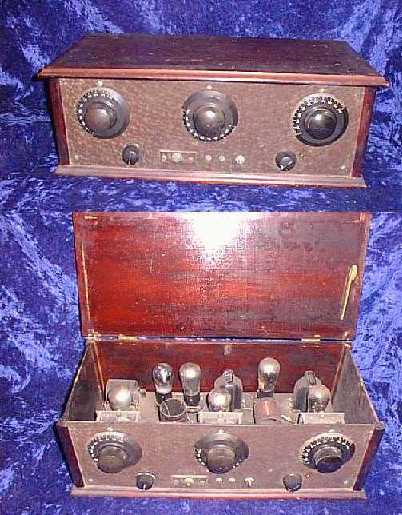
1920's Three-Dialler TRF Radio

This is the "before" photo from the guy who had it listed for sale.
Take a look at this gem!!! I got this one on an eBay auction at a reasonable price. Seems as though no-one has any idea of its origin. Its definitely turned out to be a homebrew. At first I thought it was a kit because it was so well built.
Its a classic 6-tube TRF circuit. Came with some tubes - UX201A in the first 3 stages, a UX112 detector and a pair of UX171A in parallel for the output. Shame is that one of the coupling xfmrs is open and I haven't found a nice replacement yet. All the other components are in good shape although I had to repair the rheostat on the right. Everything is of high-quality and matching, thats what made me think it was a kit.
It cleaned up very pretty. I don't think the finish is original however. Old and not in too bad a shape. The finish on one side panel is badly crinkled. If I ever get it operating properly, I might consider refinishing it or at least a good finish refurb. I solicit any comments on the possible origin of this radio.
Update - 1 May 1999
I got one of those AES power supplies (which I highly recommend) and finally put the juice to the radio. This was my first experience with a TRF and I got it playing quite easily. Quite sensitive...even got a station about 30 miles away with no antenna connected. The word shielding doesn't apply to these puppies. Its takes some tinkering to tune in a station, but it can pick up most anything that my digital Sony can receive.
With some help from several other OTs, it has been determined that its definitely a homebrew. I was able to sneak a Mouser part inside the bad xfmr case and a new .1 cap inside the case of the bad one. And the grid-leak resistor was out of whack, too. That was pretty much all the parts in the radio. As it turns out, there's 3 stages of RF Amp, the Detector, an Audio Driver and parallel Audio tubes. I'm running it with just one of the audio tubes, a UX171.
I learned alot about old-time radio playing with this rig. What surprises me most is its ability to receive so well in spite of the simplicity of the circuit. Those 1920's experimenters did a good job.

Return to Sparkbench Home Page



